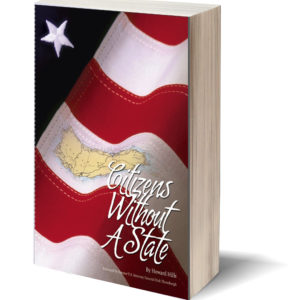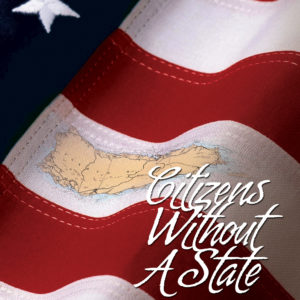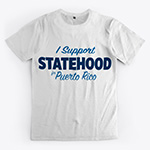When you read about Puerto Rico’s struggle to resolve the political status question, you ‘ll often see references to the Insular Cases. What are they? The Insular Cases are a series of U.S. Supreme Court rulings on the legal status and rights of people in the Philippines and Puerto Rico under U.S. territorial rule.
Until 1900 all U.S. territories were located on the North Americans continent, just like the States of the Union. As the American people moved west new territories populated mostly by U.S. citizens were formed. The U.S. territories that became states, like Ohio and Louisiana, were incorporated into the U.S. under the Constitution, with temporary territorial government until admitted by Congress as states.
Then in 1900 the U.S. acquired new territories from Spain that were islands, including Puerto Rico. These new islands were called “insular” territories because islands are geographically insulated from other larger land masses by water.
Unlike continental territories, the new insular territories were not inhabited by U.S. citizens. So the rights of the people in these islands were defined by federal territorial law passed by Congress.
When application of territorial law was challenged in the U.S. courts, the U.S. Supreme Court ruled in 1901 that insular territories would not be incorporated into the U.S. until the Congress conferred U.S. citizenship. That meant the U.S. Constitution would not apply to define the rights of the people in such unincorporated territories, unless Congress conferred citizenship at a later time.
The first of the Insular Cases was about oranges. Downes vs. Bidwell held that since the Constitution did not apply the U.S. could make laws in its territories that would be unconstitutional in the States.
Samuel Downes was a grocer who had imported some oranges. Bidwell was George Bidwell, the customs man who made Downes pay import duties on the oranges.
Downes figured that since Puerto Rico belonged to the United States, he wasn’t really importing those oranges from a foreign place to a U.S. location. Accordingly, Downes did not think he should have to pay import duty on them.
The Supreme Court was split 5 to 4 on the decision, but the majority decided that when it came to money, things could be different in unincorporated territories. At least until the U.S. Congress decided that those unincorporated insular territories were “an integral part” of the United States and conferred U.S. citizenship on the people, thereby also triggering application of the Constitution.
The ruling in Downes and the line of territorial law court decisions known as the Insular Cases created a new class of territories under U.S. rule, populated by non-citizens and governed under federal statutes without direct application of the Constitution. The legal and political nature of this court made unincorporated insular territory status is still beguiling and befuddling legal scholars to this day.
For example, Bartholomew Sparrow, a scholar on the subject, said it like this:
“In one of the most important of the Insular Cases, Downes v. Bidwell, the Supreme Court established that the United States was not just a nation of states and temporary territories; it was a nation of states and potentially permanent territories.”
This analysis is wrong, because the Insular Cases do not make unincorporated territory status permanent. Instead, the Insular Cases make unincorporated territory status indefinite. Since the federal territorial law interpreted by the Insular Cases is adopted by Congress it can be amended or repealed by Congress.
Congress could end unincorporated territory status or change the form of territorial government and law at its pleasure. Since one Congress can not pass a law that binds a later Congress, unincorporated territory status can never be made permanent.
Similarly, while the Constitution applies in U.S. citizen populated territories that are incorporated and on the path to statehood, the period of temporary government before statehood also is indefinite and the territory’s status is not permanent until the territory is admitted to the union.
The reason Puerto Rico remains in a temporary status as a U.S. territory, rather than a permanent political status like a State of the Union or a nation of its own, is that the U.S. Supreme Court made a very confused ruling about Puerto Rico in 1922.
While viewed by many legal scholars as one of the Insular Cases, the Balzac ruling actually deviates from the unincorporated territory doctrine of the Insular cases, as well as the U.S. Supreme Court’s rulings on the status of incorporated territories that became states.
Here is the explanation. Before Balzac there were two categories of territories. The first was the traditional territory populated mostly by U.S. citizens, incorporated under the Constitution. For example, shortly after the Downes case was decided in 1901, the court ruled that Alaska and Hawaii were incorporated under the Constitution because Congress conferred U.S. citizenship in those two territories.
The second was unincorporated status under Downes and the Insular Cases, in which non-citizens are governed by federal territorial law outside the Constitution. For example, the non-citizen people of the Philippine territory were governed as unincorporated territory under federal territorial law, and in 1916 Congress passed a law providing that U.S. citizenship would not be granted there. Instead the U.S. put the Philippines on the road to independence and nationhood, which was achieved in 1947.
The legal and political order for U.S. governance or U.S. citizen populated incorporated territories and non-citizen populated unincorporated territories was sabotaged by the Balzac case in 1922, in which the court created a third category of U.S. territory. Specifically, the court ruled that Congress can govern Puerto Rico outside the Constitution even though Congress had conferred U.S. citizenship in 1917.
This meant that for the first and only time in our history U.S. citizens in a territory (Puerto Rico) would not be governed in the same manner as U.S. citizens in 32 territories that became states between 1796 and 1959, including Alaska and Hawaii. Instead, under Balzac the conferral of U.S. citizenship is treated as non-event, and as a result the U.S. citizens of Puerto Rico are governed under the Downes unincorporated territory doctrine as applied to the non-citizens of the Philippines.
This contradicted the ruling in the Downes case that the unincorporated territory doctrine applied only until Congress conferred U.S. citizenship. Balzac also contradicted the ruling of the U.S. Supreme Court in the Alaska and Hawaii cases that conferral of U.S. citizenship meant those two territories were incorporated under the Constitution.
In the Balzac case Jesús M. Balzac, a journalist, had been found guilty of libel in Puerto Rico when he criticized the governor of the territory. He claimed that his constitutional rights as a U.S. citizen were violated by Puerto Rico’s legal system, because there was no jury trial for misdemeanors in Puerto Rico at the time.
The Supreme Court said that Puerto Rico, an unincorporated territory, wasn’t governed by the Constitution in the same way as Alaska, an incorporated territory. In this case, the court’s decision was unanimous. They pointed out that the first of the Insular Cases in 1901 had led to a statement that some personal rights guaranteed under the Constitution were so important that they would have to apply to everyone… but none of the decisions in the Insular Cases said exactly which rights those were.
The Insular Cases have been questioned by many scholars since that time, but Balzac continues to allow the people of Puerto Rico to be treated as second-class citizens.








10 Responses
[…] Puerto Rico were citizens. Some discussed the complex issues thoughtfully and with reference to the insular cases and the 2012 […]
[…] in 2007, but Thornburgh’s book argued that the legal and political complications of the Insular Cases and the problems with the current status of Unincorprated Territory made it difficult to settle the […]
[…] What are the Insular Cases? […]
[…] Puerto Rico, and the other U.S. territories, differently from the States. The Supreme Court in the Insular Cases famously ruled that the U.S. Constitution did not apply to the people in the island territories in […]
[…] influence our politics today. They are what prevent these territories from achieving statehood. In 1922 Congress ruled that in the case of Puerto Rico (the most likely candidate for American Statehood), Congress itself, can govern outside the […]
Should we statehooders fail to revisit past History, we will then fail to find the truth, the pure, objective truth about the reasons behind apparently unexplainable historical, political and judicial events. We must then set aside some time to examine pasta history in order to be “on target” and find the historical truth, lest we should risk ridiculing ourselves by issuing opinions not grounded in the stark, historical truth rather than continuing to fail in the most precise, and correct evaluation of the true historical facts of History. A fellow pro statehooder, the Hon. Felix Cordova Davila, after substituting for Luis Munoz Rivera, took charge of the chair of Resident Commissioner, and when confronted with U.S. racism as faced in Washington, D.C., wrote to the grandfather of the ex Governor, Carlos Romero Barceló, the Hon. Antonio R. Barceló, and explained to him the reasons why the statehood cause could not advance in Washington D.C., nor the cause of advancing other rights claimed by the People of Puerto Rico. See “Lic. Félix Córdova Dávila, Comisionado Residente de Puerto Rico en Washington, Carta al Senador Antonio R. Barceló, 22 de noviembre de 1917, La Obra de Félix Córdova Dávila, Vol.II, Correspondencia Política Félix Córdova Dávila y Antonio R. Barceló (1917-1921), Oficina del Historiador Oficial Asamblea Legislativa de Puerto Rico, San Juan, 2008, p.204”. I quote from a letter sent by this fellow statehooder to Carlos Romero Barceló’s grandfather:
“Los americanos tienen la creencia de que todos los Portorriqueños somos negros y esta es una de las causas principales que contribuyen a que no se nos reconozcan todos nuestros derechos y a que se nos crea inferiores.
El día que se acabe de convencer de esto por una manifestación nuestra, por confesión propia, se quitarán el disfraz y nos tratarán como animales que es como ellos consideran a los negros.”
If we revisit past history, we will find that the U.S. Government conducted a census in P.R. See pages 85-94. The Puerto Ricans were classified as “negroes, multtoes, mixed people [mestizos] and “inferior races, thus not apt nor destined towards
Statehood. (U.S. Commanding Officer, Brig. General George W. Davis, Report on Civil Affairs, Part 13, pages 84-95. “80% of those who rate themselves as “white” would be considered “colored” or “negroes” in the United States.” Then, on page 34 he declared that “the Puerto Ricans are what they are [negroes, mulattoes, mixed people] and can not be metamorphosed into anglosaxons.” (General George W. Davis, 1900, Report on Civil Affairs, Part 13, page 35).
[…] What Are the Insular Cases? | Puerto Rico 51st […]
[…] and 1922, dealt with territories of the United States, such as Puerto Rico and Guam. The theme of these opinions, based on evident racist presumptions, was that the people residing here were not entitled to all of […]
[…] The Insular Cases involve a series of decisions that address the legal status and rights of people under U.S. territorial rule, according to blog posts, including a January post from the state bar association. The original 1901 decision said the territories wouldn’t be incorporated into the U.S. until Congress conferred U.S. citizenship to them, and that, therefore, people living in such territories wouldn’t be afforded constitutional rights, according to a post from pr51st.com. […]